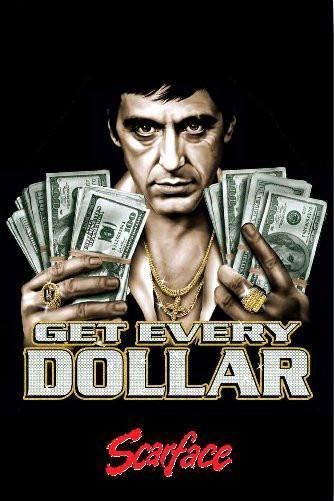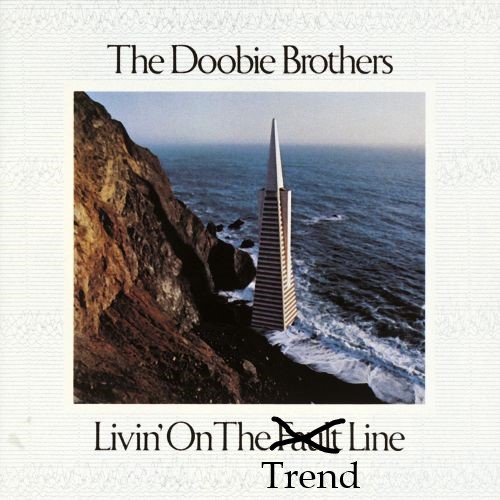I don't think I'm exaggerating when I say the pivot to poetry was the biggest event of the year for me. I got disillusioned with the grind of trying to be a film writer (I can't begin to imagine the grind of actually being a film writer) and wanted to write something for fun. So I gave poetry a shot. I started in the summer, wrote 31 poems in October, and I haven't looked back since.
I also gave flash fiction a try.
My podcast Middlebrow Madness, which I do with my pal Isabelle. We are two very different flavours of cinephile, and it's always a blast talking with her about the ins and outs of why a movie did or didn't work.
The pod's conceit (the IMDb Top 250 fed through a single-elimination bracket) gave me the chance to rewatch several masterpieces this year: Seven Samurai, Fargo, No Country for Old Men, Chinatown, Perfect Blue, North by Northwest, 2001: A Space Odyssey.
Jank City. Against all odds, my playgroup's dollar-store Magic: The Gathering draft (which I more or less run solo) has become something of an Event, drawing in more and more people into our ridiculous shenanigans. We have lore, a championship title lineage, feuds, and a Money in the Bank-style briefcase that has yet to be cashed in. It's great.
The launch of the Criterion Channel, which continuously spoils us rotten with some of most brilliant and awesome movies of all time.
The ongoing saga of Dim the House Lights, the little film-crit concern that could.
The continuing excellence of SB Nation's Jon Bois. There was the search for the saddest punt in the world. There was The Bob Emergency, which was my favourite documentary of 2019 (the chapters on Bob Gibson and Bob Beamon alone are worth the price of admission). There's Fumble Dimension, his new collaboration with Kofie Yeobah (who also wrote the brilliant essay “Can a team of 25 Ichiros win the World Series?”. And there's the ongoing, slightly retooled, still excellent Dorktown, co-hosted by Alex Rubenstein.
You know what? I'll just plug the rest of SB Nation here, especially their YouTube channel. Check out this episode of Rewinder, where they do a kayfabe deep dive into the closing moments of Space Jam.
Fuck it, one more: SB Nation's Twitter thread of the best sports GIFs of the decade.
Desert Bus 2019. Every November I take a week off work and live on west coast time to follow LoadingReadyRun's 160-hour-plus stream-a-thon, buzzer to buzzer.
The aforementioned LoadingReadyRun had a banner year in 2019, thanks in no small part to Road Quest, an ambitious short-form series whose elevator pitch is more or less “Top Gear, but wholesome.”
All Fantasy Everything. Still the podcast I look forward to the most every week. One of the few Patreons I donate to. Listening to Ian, David, and Sean go on a national tour this year was fantastic. Some of my favourite drafts from this year: road trips, things you yell after you dunk on someone, lies we tell ourselves, things to do on a rainy day, and bucket lists.
The YouTube output of Bailey Fakelastname, aka Foolish Baseball. His Baseball Bits show is fun, charming stat-wonk stuff. As a long-suffering Expos fan, I appreciated his plea to elect Larry Walker to the Baseball Hall of Fame.
The Fantasia International Film Festival, the best god damn film festival on Earth. I got to see Phantom of the Paradise at the Imperial with Paul Williams in attendance. I also caught the beautiful restoration of the 1981 psychedelic classic Son of the White Mare and anime godhead Masaaki Yuasa's lastest Ride Your Wave.
I saw this at Fantasia last year, but it only went wide this year: Relaxer. Joel Potrykus is one of the brightest, boldest voices in American indie cinema right now, and this might very well be this sweaty, sticky, milk-puke masterpiece. A Herculean physical performance by Joshua Burge. Awesome score by Neon Indian.
Olivia Colman's Oscar speech.
Upgraded my phone to a fancy-schmancy iPhone XR.
Krispy Kreme opening a downtown location in Montreal, directly across the street from the local game store my Magic playgroup calls home. The Original Glazed might be the perfect donut. I ate many of them this year.
Kawhi Lenoard and the Toronto Raptors bringing the hardware home.
This Twitter thread of crazy Vince McMahon stories.
Tokyo's Friday Night Plans and their cover of ur-City Pop jam “Plastic Love”.
City Pop's eternal summer. By all accounts, City Pop proper died in the 1990s, but that hasn't stopped this ongoing resurgence the genre is having. Between intrepid YouTubers uploading LP rips and being used as the raw materials for vaporwave and future funk, City Pop is still in the midst of its moment. I wrote up six albums I felt were key to the genre in its heyday.
Light in the Attic Records. This awesome Seattle label has reissued tons of classic and obscure country, folk, blues, R&B, and soul albums, plus avant-garde curios, film scores, and two of the best proto-ambient/New Age compliations I've ever heard. Oh, and they also released an awesome City Pop compliation called Pacific Breeze.
The Lighthouse. A+ psychosexual chiller, funnier than I had anticipated. Both Robert Pattinson and Willem Dafoe go hard. Robert Eggers is the real deal.
A full decade with my girlfriend Steph.
For The New York Times, Jessa Crispin on Instagram, aphorisms, and the legend Dril.
Hbomberguy revisits Transformers: The Movie as a grown-up and talks about nostalgia as a prism.
Bringing my turntable out from storage. It still sounds like shit, but I'm working on it.
For The Believer, Molly Brodak on Tim Heidecker.
Speaking of Tim Heidecker, his LP What the Brokenhearted Do... is a great 70s-flavoured singer-songwriter album, like Warren Zevon or Harry Nilsson, but more fucked-up.
The movie-centric podcasts from The Ringer, especially The Rewatchables. I'm kind of enamoured with the idea of a “cable canon” (i.e. movies that play really well at 3pm on a Sunday), and there's a lot of overlap between movies I would include in that particular canon and the movies they cover here. Chris Ryan 4 prez.
Discovering the work of Bay Area power pop genius Tony Molina. I must have listened to “Nothing I Can Say” 300 times this year, because it's everything I want in a song compressed into 71 seconds. His rarities comp Songs from San Mateo County was one of my favourite albums of the year.
I fell off the Pokémon train a while ago, but I was not immune to Wooloo Fever.
Pivoting to poetry means reading more poetry, and one of the first people whose work I got acquainted with Kenneth Koch. His Selected Poems (edited by the homie Ron Padgett) was one of the best things I read all year. “The Art of Poetry” is about as good as a mission statement gets.
Knives Out. Basically Rian Johnson's Clue, or his crack at a contemporary Agatha Christie story. A rip-roaring good time made all the better by Daniel Craig's goofy Southern drawl. Proves that there are few pleasures out there like listening to someone unspool a whodunit in the home stretch.
Getting a promotion at work.
A little live French-language comedy podcast called 70%. Imagine a local cable access variety show spliced with the more subversive and absurd tendencies of the best of late-night talk shows, but set at a bar in Rosemont and released as a podcast.
Doing an escape room for the first time at Ezkapaz.
RIP David Berman. That Purple Mountains album is now one of the great bittersweet musical documents of all time.
Spotify's Cosmic Country playlist.
Uncut Gems. I had high hopes for this one after Good Time topped my list of favourite movies in 2017, and boy did they come through. This movie is a nerve-eroding two-hour-long shouting match between all parties involved, and I could have watched it for another five. Adam Sandler doing some career-best work. Awesome score by Daniel “Oneohtrix Point Never” Lopatin. FYC Julia Fox. FYC Lakeith Stanfield. FYC Eric Bogosian. FYC Mike Francesa. FYC fuckin' everybody in this.
The QAnon Anonymous podcast, an absurd political podcast for our absurd political climate.
Covering the U.S. Open for work and watching Bianca Andreescu ascend to the highest ranks of tennisdom.
Sturgill Simspon's Sound and Fury. A hard zag from his last two records. This time he channels Mad Max, Eliminator-era ZZ Top, and just a little bit of Black Mountain's synth revisionism and feeds his superior songwriting skills through those filters. My favourite record of the year.
Re-upping my membership to the cult of Road House.
The work of Jia Tolentino, who is uniquely perceptive about our cultural moment because she writes about it from the eye of the hurricane. Trick Mirror is required reading, and her New Yorker essays have a very high hit rate.
Jenny Odell's How to Do Nothing, a user's guide to navigating a splintering world devoid of decompression. Pair with Trick Mirror to have your very soul sand-blasted.
Reading my poems in from of actual-ass human beings at the Argo and at the Accent Open Mic reading series.
The Irishman. A master stares down the barrel. Grand and masterful. Death and legacy. “Who are you protecting?”
Related: the Martin Scorsese-Marvel feud (Vox's Alex Abad-Santos has a pretty good breakdown of the whole ordeal here). His op-ed in the Times was great reading.
Christopher McQuarrie's Twitter thread (archived here by No Film School) about getting started, applying ass to chair, and “playing the lottery.” Key quote: “The secret to knowledge is doing and failing – often and painfully – and letting everyone see.”
The work of Austin Kleon. Keep Going was a key read this year. His blog is one of my favourite places to go when I'm feeling stuck. His newsletter is a joy. Hell, I nicked the idea for these lists from him! I owe that guy a beer, maybe several beers.
Untitled Goose Game. Sometimes all you need in life is to honk at a motherfucker and steal his hat while Debussy plays.
Parasite. Rhymes with Bong Joon-ho's previous film Snowpiercer, another bugfuck class-struggle whatsit. Only this time, it's operating as a dark-comic tightrope thriller. Galvanizing and infuriating. The odds-on favourite for title belt for this year.
Dumping an aging, bloating iTunes for MediaMonkey.
My friend Karen's newsletter Don't Threaten Me With a Good Lifetime, where she breaks down Lifetime movies in agonizing, hilarious detail.
The Merlin Mann Podcast Universe, the load-bearing beam of my podcast feed: Back to Work, Do By Friday, Reconcilable Differences, and Roderick on the Line.
People Dancing to Steely Dan.
Speaking of, there was a mini Steely Dan retro at Pitchfork in November, which, as a dad rock lifer, I can appreciate. I quite liked Amanda Petrusich on Aja and Alex Pappademas on Gaucho.
Live pro wrestling at a gay bar downtown.
My beard and my temples have started to gray, so I'm taking baby steps towards becoming a silver fox, which sort of rules.
The work of William Matthews, especially his poetry collection Time and Money. Some favourites: “The Bear at the Dump” and “Mingus at the Showplace” from Time and Money, and “In Memory of the Utah Stars” and “Foul Shots: A Clinic” from Rising and Falling.
Seeing my friend Noah rip it up on clarinet live with Montreal-via-Ottawa rock band The Maximum Chill.
Pivoting from Slack to Discord. Can't abide having the archives behind a paywall.
The Bon Appétit YouTube channel. I jammed all the Gourmet Makes videos over the holidays.
Werner Herzog x WrestleMania. “A poet must not avert his eyes.” Bonus Herzog content: the great man on his favourite cat videos.
John Carpenter's weed-dad sci-fi opus Dark Star turned 45. I wrote it up here.
Inspired by the case of a post office that shut down due to a snake infestation, my pal Justin made a zine called The Snake Post Office Post, which features a poem by yours truly.
My friend Carl's poem about Vincent D'Onofrio.
A Hidden Life. Beauty and despair, faith and cruelty. No one does it like Terrence Malick. James Newton howard brings the thunder.
My coworker Emmanuel gamely rapping his way through Die Antwoord's “Enter the Ninja” at a karaoke dive bar in Villeray.
Saying “fuck it” and buying a bright red Dickies suit and cuting off the shins. The “shoveralls” were thus born.
The Suspense Is Killing Us. Three guys affiliated with the world's largest video store talk about trashy thrillers from the 80s and 90s. Probably the best podcast to debut this year.
Playing Magic: The Gathering and crushing Palm Bays with the homies (because White Claw hasn't crossed the border yet).
My Mastodon instance laserdisc.party trucks on!
I joined a sports-themed Mastodon instance that my friend Thomas started, allpro.social.
Related to the last: allpro watching the Washington Nationals beat the Houston Astros in the World Series together.
Me and Steph's annual-ish summer jaunt to Toronto.
Once Upon a Time in Hollywood. I am in the tank for Quentin, that much is known, but this shaggy-dog hangout movie/love letter to late-60s L.A. plays like his Inherent Vice. His best since Inglourious Basterds.
Every year, there's one album I'm familiar with in passing that I get stuck on, listen to on repeat, and induct into my personal pantheon. And this year, that honour goes to the Clientele's Strange Geometry. Congratulations, fellas!
Divided by Darkness, the latest from Phoenix metalheads Spirit Adrift. which filled a Preistess-shaped hole in my heart with it's NWOBHM worship, Thin Lizzy worship, soaring triumphant chorus worship. Riff city, baby.
The video work of Adam Neely, an NYC-based bassist and YouTube. I'm kind of a music theory dunce, but his videos are approachable and the non-theory stuff, especially the vlogs detailing the life of a gigging musician, are fascinating. The video that hooked me was the one where he recounted his worst musical trainwreck, where he and his bandmates eviscerated “Can You Feel the Love Tonight.”
Make Do. A small podcast about the up and downs of making art.
John Wick: Chapter 3 – Parabellum. In a perfect world, the first entry in a trilogy sets up the world, the second entry expands the world, and the third entry subverts its rules. All three John Wick movies excel at each level. The superlative action franchise of the century continues.
Jenny Lewis's On the Line. Rock album as liminal space. The chief vibe on this one is “I'm not drunk I'm sad (okay I'm a little drunk).”
Ad Astra. What's the worse thing to be stuck in, unable to reach out from: the vacuum of space or inside your own head? Or: in space, no one can hear your abandonment issues. It's plays like an artier, sadder version of The Martian. Max Richter with the big assist on this one.
Strand of Oaks's Eraserland. Giant, shimmering, weary heartland rock, pulling from a similar tetxtural well as fellow Philedelphians (and perennial Derek favourite) the War on Drugs.
Reacquainting myself with the work of Richard Hugo. I bought his collection Making Certain It Goes On and his essay collection The Triggering Town and hoovered both of them. I read “Degrees of Grey in Philipsburg” at an open mic. I watched a documentary about his life. He was a working stiff for most of his 30s and only published his first book at age 38. I pull a lot of water from this particular well.
Men I Trust's Oncle Jazz, the Montreal album of the year, a beefy, slinky, chill-as-shit post-vaporjazz dream-pop missive, 70 whole minutes of it. Drowning in a sea of reverb and hushed vocals. Sounds like having been awake for 30 hours in a city that's not your own. Amazing stuff.
New kitchen appliances. My microwave was from the 1990s, so I was due.
Sunn O)))'s Life Metal. Riffs like ziggurats meant to be played so loud your bones hum.
The work of A. R. Ammons. By turns funny and cosmic, looking at nature with the eye of a biologist and the I devoured his Selected Poems (the Library of America coming in clutch again), and especially loved the excerpts from Tape for the Turn of the Year, which was typed on a roll of adding machine paper, and Garbage, an epic about the natural world and our place in it.
Danny Brown's uknowhatimsayin¿, an inventive and kaleidascopic rap record. Brown might be the funniest MC currently working. The cameos by Run the Jewels and JPEGMAFIA don't hurt either.
All Elite Wrestling, making good on the promise of All In last year. Chris Jericho's run as champion here bolsters his own claim that he's the GOAT.
Nick Cave and the Bad Seeds's Ghosteen. I made the mistake of listening to this beautiful, heartbreaking record at work. Word of advice: wait until you leave to office to jam a song like “Waiting for You”.
Alita: Battle Angel. “Cyberpunk anime Rollerball” is the easiest sell of all time.
Camino 84's Yacht Rock Breaks 2. Exactly what it says on the tin. Smooth as shit.
Shout out to Ron Padgett. I read and loved Alone and Not Alone, and look forward to cracking open Big Cabin. Now that I think about it, the pivot to poetry might have been preipitated by his work on Jim Jarmusch's brilliant film Paterson.
The teaming-up of director Jesse V. Johnson and actor Scott Adkins. Their work together this year, the DTV Action Movie All-Star Game that is Triple Threat and the gnarly, purple revenge jam Avengement, are both splendid additions to the disreputable action canon. There is currently no more fecund partnership in action cinema.
 art by
art by 



 Illustration:
Illustration: